Many thanks to SWLing Post contributor, Julian S, who shares the following guest post and review:
Panasonic RF-B45 – A Comparative Review
by Julian S
18 and 19 October, 2022
I was raised on valve / tube radios. From my pre-teens in the 1960s, I enjoyed tuning through the frequencies as a form of exploration. In the 1970s I experimented with antennae to improve reception. And later, starting in the 1980s, I began to use travel radios, always looking for that perfect radio.
Today the perfect radio for us SWL’ers might need to include a time machine to take us back to the halcyon days of SW, say in the 1980s or 1990s, before so many Western broadcasters axed their Short Wave services.
Looking at the BBC World Service’s latest round of cuts, I am filled with horror. Is whoever decided those cuts deeply cynical or deeply ignorant?
Switching BBC World Service content from radio to the internet for countries that block or restrict internet access is not the way to reach people living there. In places where every person’s internet access is monitored, where access to websites and web-content is censored or blocked, BBC news internet content will not be widely available. Today and for the foreseeable future the way to reach perhaps half or more of the world’s population is radio, especially Short Wave radio broadcasts.
The People’s Republic of China (PRC) and other like-minded countries, eg the DPRK (North Korea) fully understand the importance of radio, especially Short Wave and they vigorously maintain multiple Short Wave broadcast programmes as a way to project soft power and influence people.
In this context, it’s no surprise that when the Australian Broadcasting Corporation in 2017 suddenly, unexpectedly and against a back-drop of protests from Pacific Island Nations and rural Australians ditched its Short Wave broadcasts, the PRC’s China Radio International grabbed Australia’s SW frequencies.
I heard that in an earlier round of cuts China acquired frequencies dropped by the BBC World Service.
By the time the West wakes up again to the importance of Short Wave radio broadcasting as a means to communicate to the world, they will find the SW airwaves are full of PRC, North Korean, Vietnamese, Cuban and other broadcasters who never forgot how important SW broadcasts to the world are. I’m reminded of a line from the Sean Connery film, Rising Sun, “If you don’t want us to buy it, don’t sell it.”
Aside from the broadcasters mentioned above, there are still many others broadcasting on SW and there are plenty of Hams too. Short Wave radio listening and Ham radio are widespread and popular in Asia and Africa and are a major source of news. In some countries SW is also used as a means of business and social communication. So much so that there are home-grown radio and transceiver manufacturers in a number of African and Asian nations.
SW listening is big in China. So it’s no surprise that probably the best manufacturer of consumer grade short wave radio receivers is a China based company, Tecsun, who need no introduction. Tecsun seems to have taken over the role that was once held by Grundig, Sony, Panasonic and others. Indeed many of the later Grundig models are made by Tecsun.
If you’ve guessed that I like short wave radio, you’ve guessed right. And I suppose like many other fans, I usually have my eye open for something special.
Since hearing of the Panasonic RF B65 some years ago, I’ve been on the look-out for one at a reasonable price… this search led me to the RF B45…. But I’m a man of modest means so I need them to be priced accordingly.
Usually these two 30+ year old radios are priced on North American eBay like holy grail radios. More expensive than a 2nd hand Sony ICF 2010 / 2001D. Go figure. But the other day I found a Panasonic RF B45 for what I considered a reasonable price. It arrived yesterday, well packed, clean and in good condition. After dinner and this morning before breakfast I put it through some of its paces
What follows are some initial impressions of the Panasonic RF B45:
I’ve read a few reviews of it on eham, shortwave.ch etc. The controls are pretty easy to figure out. It has a similar form factor to the Sony ICF7600 series and is probably comparable in performance to the digital iterations of the Sony 7600 series… though the only 7600 series radio I have at present is the analogue 7601 which is comparable to the Tecsun R9700DX, except in price. New the Tecsun R9700DX is likely to be cheaper than a used Sony 7601 on eBay, and the Tecsun has a wider range of features, eg external antenna socket, comes with a long wire antenna, has better audio… but I digress…
…back to the Panasonic RF B45. This is a fine compact travel radio about the size of a paperback book or two DVD stacked boxes.
In its day – circa 1991 – the RF B45 was a top of the range travel receiver. It still is.
In terms of features it is more spartan than the Panasonic RF B65 though some reviewers say the ’45 and ’65 have similar but slightly different circuitry. I’ll take that on trust. Both receivers’ service manuals with schematics are available on the web, though I haven’t done a comparison of their circuit diagrams. Here are a couple of links:
https://archive.org/details/manual_RFB45_SM_PANASONIC
https://www.hifiengine.com/manual_library/panasonic/rf-b45.shtml
I compared the Panasonic RF B45 with some of my Tecsuns: a Tecsun PL-330, Tecsun PL-660, Tecsun PL-880X and a Tecsun PL-990X. Using their whip antennas and built in loudspeakers for Short Wave, the Tecsuns have clearer, better, more intelligible sound. But then Tecsun is known for the good audio of their portable radios – and they are venturing into the HiFi market too.
I was surprised by how clear and pleasant the Panasonic RF-B45 sounds with its onboard loudspeaker. This is a radio one could enjoy using to listen to strong signal broadcasts on any frequency for hours.
I live in Hong Kong. And since Hong Kong stopped re-broadcasting the BBC World Service 24/7 on MW, I like to listen to the Beeb on SW. Though RTHK, Hong Kong’s equivalent of the BBC, often uses BBC World Service reports in its news, I prefer to get the BBC on SW.
Listening conditions can be challenging. A lot of RFI and Faraday cage effect. We live in an old low-rise building surrounded on all sides by steel framed or reinforced concrete skyscrapers. And our own building also has a reinforced concrete frame, floors and ceilings, making it a quasi-Faraday Cage. My FRG7 is almost deaf in these conditions. But the Tecsuns, Drakes, Sonys, Belka and Malahit (original not fake) and now the new addition the Panasonic RF B45 all work surprisingly well. Listening to RTHK Radio 3 on MW 567KHz, I see the Panasonic needs alignment, its dial peaks the broadcast at “558”KHz, but if truly tuned to 558KHz, the broadcast signal is in fact degraded.
With stereo headphones the Panasonic delivers sound to one channel only, unlike the Tecsuns which even with mono frequencies and broadcasts, e.g. SW, MW and LW deliver two channel sound – which to my ears makes a considerable difference.
By 1991, the year the RF-B45 came out, mono with a single ear bud was already an antiquated way to deliver sound. Perhaps my radio has a defective headphone socket, I asked myself? No. A quick look at the on-line service manual shows the supplied “earphone” is just that, a single mono earbud and the earphone socket is a mono socket. A strange, likely cost-saving, decision to make for a top-of-the-line travel radio in 1991. I will see if I can find a mono to stereo adaptor plug so I get sound in both sides of my headset.
I like the form factor of the Panasonic RF-B45, it has a slightly curved front, rounded edges, the buttons are nicely spaced and well-made and even after 30+ years everything works smoothly and without fuss, pretty impressive statement about build quality. It has a tilt stand at the back and a nice heft to it. Panasonic’s engineers clearly put thought into the design. And even after 30+ years it works well and is comparable to the better modern offerings.
I’ve hunted high and low all over the ‘web for a detailed comparison between the Panasonic RF-B45 and the RF-B65. But I have yet to find one. I’d really like to know how the RF B45 and the RF B65 compare with one another and with the current comparable range of Tecsuns, eg the much smaller Tecsun 330, the similarly sized Tecsun 660, 680, 880 and 990.
Listening to the BBC World Service on 11.865MHz earlier this evening I had to use the fine tuning to centre the broadcast, but once centred, the signal was clear, the audio excellent and the background noise negligible. The Tecsuns received the signal better and did not need any fine tuning, they were spot on. But the background noise level on the Tecsuns seems higher.
The Panasonic RF-B45 has digital tuning in 5KHz steps which is displayed on the frequency counter. Main tuning is done by one of three methods:
- Entering the desired frequency via a key-pad
- Manual scanning using one of two buttons to scan through the frequencies
- Auto scanning
In addition it has a rotary fine tuning knob to centre a transmission, fine tuning is also used to demodulate a transmission when the radio is switched to SSB. The fine tuning steps are not displayed on the frequency display. I have not yet tested this radio on SSB, nor have I compared it with SSB on any of the Tecsuns.
I’m glad to have the Panasonic RF-B45, it’s a nice radio and a bit of nostalgia. But it’s not quite as versatile or as good at snatching a signal out of the air as my Tecsuns. The Panasonic does not have a rotary main tuning knob, which I miss. Some versions have an external antenna socket, though mine does not. But one could clip a long wire to the telescopic antenna, or fit an antenna socket to it if you were so minded. It is a mono radio, even in FM and it has single channel mono to only one channel of stereo headphones, meaning a listener will only hear the sound out of one side of the ear buds or headphones. But audio from its speaker is excellent.
Given its price and limitations, if you’re in the market for a go-to travel radio, I’d give it a miss and go for one of the Tecsuns, unless you manage to find the Panasonic for a really low price, in which case snap it up!
But if you’re looking for a nice piece of early PLL digital radio nostalgia it’s a good radio to have.
Finally a quick personal note about travel radios. I love the Sony ICF 2001D / 2010. I have 4. They are all dead. Cause of death? Capacitoritis. Failed / leaking capacitors seems to be a common problem with many Sony products. Was it a case of designed and engineered in-built obselescence? Or is there some other cause?
Sony has a fine display room in Hong Kong an entire floor in a major building. A playground for Sony fans. For years I tried to order from them an ICF 7600 GR, which no one in Hong Kong stocked, they declined to order it for me. I had an early analogue 7600 which disappeared one day. I was very pleased in the early 2000s to find a new 7601 in a department store. This has suffered various ignominies and no longer works. The other day I was delighted to find for about US$18.00, a clean 2nd hand 7601 on a street stall in Ap Liu Street, Hong Kong’s equivalent to Tokyo’s Akihabara electronic fish market… yes they even sell fish near by.
But after trial and error for some years now my go-to travel radios are the Tecsun PL-880X and PL-990X. When I bought my first 880 I couldn’t believe it. What excellent sound. What good looks, how intuitively it’s laid out and how amazing that in SSB it tunes in 10Hz steps. And then the 990X came out. For SWLing, I prefer the 990X. Interestingly, I’m told, the 990 uses the same loud speaker as the 880. But the speaker enclosure is different so one doesn’t get the mellow bassy sound of the 880. Instead the 990 has a crisper sound.
Over the years my son and I have acquired many of Tecsun’s travel radios. The Tecsun Ham-2000, aka Grundig 800 which is a reconfigured Drake SW-8, S-8800, PL880X, PL990X, PL330, PL660, PL368, PL365, Degen DE-1103 (the original, not the DSP), Degen DE-321, and the Tecsun S-2000 aka Grundig 750. All of these are good radios for what they do and are. And I recommend them all. My only reservations are about the S-2000, which is the most expensive of the current production and while a lot of fun to operate, in my view out of the box and unmodified it’s not up to the level of the other serious Tecsun SWLing radios. Tecsun radios are available from many sellers on the internet. I don’t have experience of all of them. The sellers I trust are Anon-Co and Tecsun Australia.
I really like the Panasonic RF B45 and enjoy using it. However, when I next travel I’m not likely to take it with me, unless I’d like to compare it with other radios in better listening conditions. That’s partly because of its comparative rarity and partly because in my view it’s not quite as good as the PL-880X or the PL-990X. Having said that, the RF B45 is an excellent travel radio and if you have the opportunity to buy one in good condition at a reasonable price, get it!
I found a recording comparing the RF B45 with the PL880X and another comparing the RF B65 with the PL880X – to my ears the 880 sounds better. What do you think?
Panasonic RF B45 vs. Tecsun PL-880 – Doug’s videos
Panasonic RF B65 vs. Tecsun PL-880 by frequent SWLing contributor Oxford Shortwave
Thanks Doug and Oxford SW for posting your videos.
Disclaimer: I do not own shares in Tecsun, Anon-co or Tecsun Australia nor do they give me free radios.

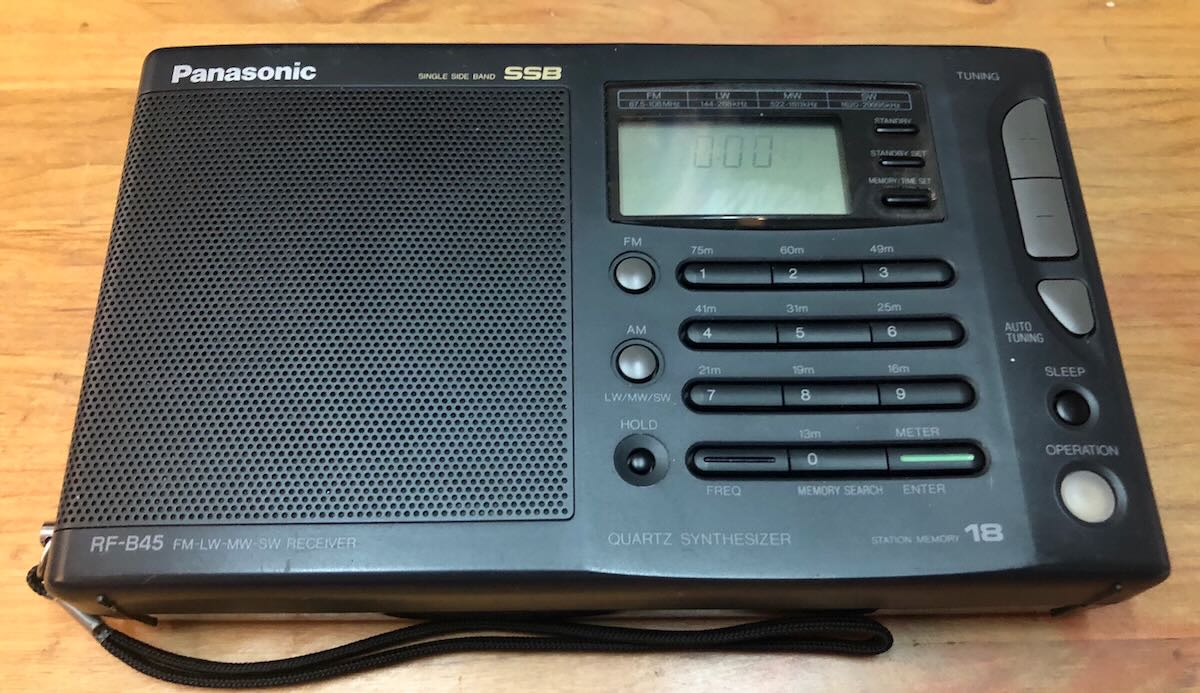
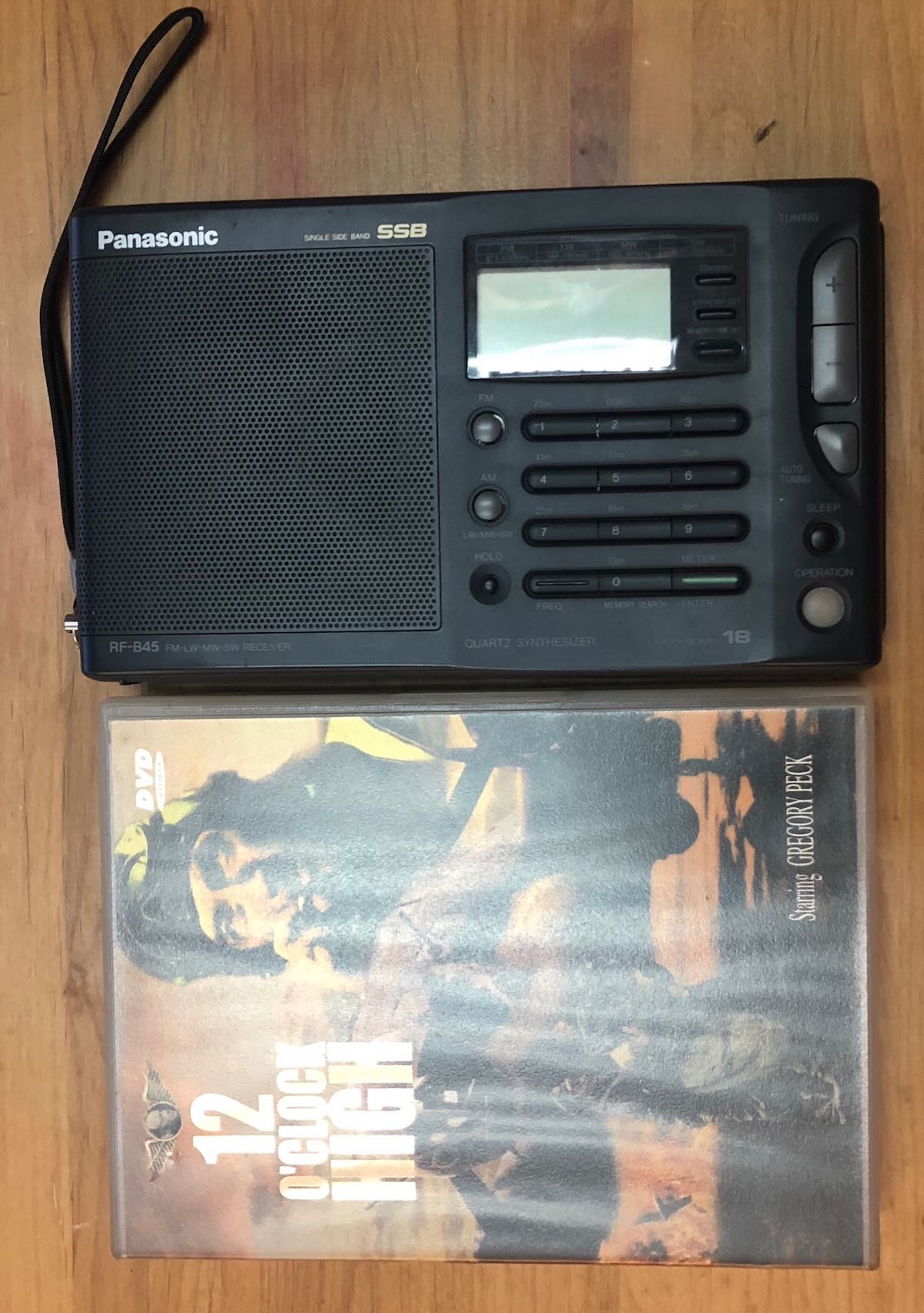
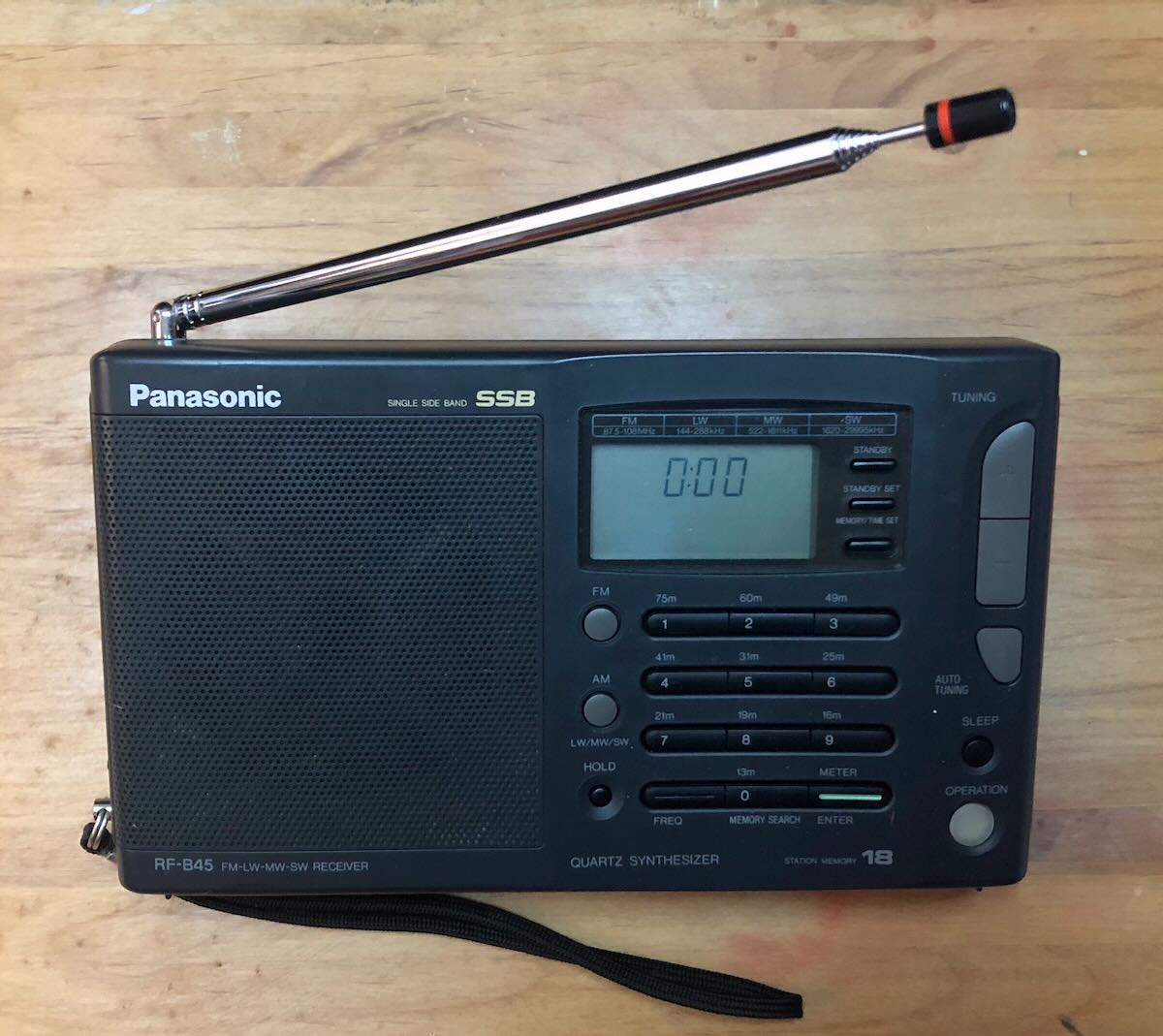
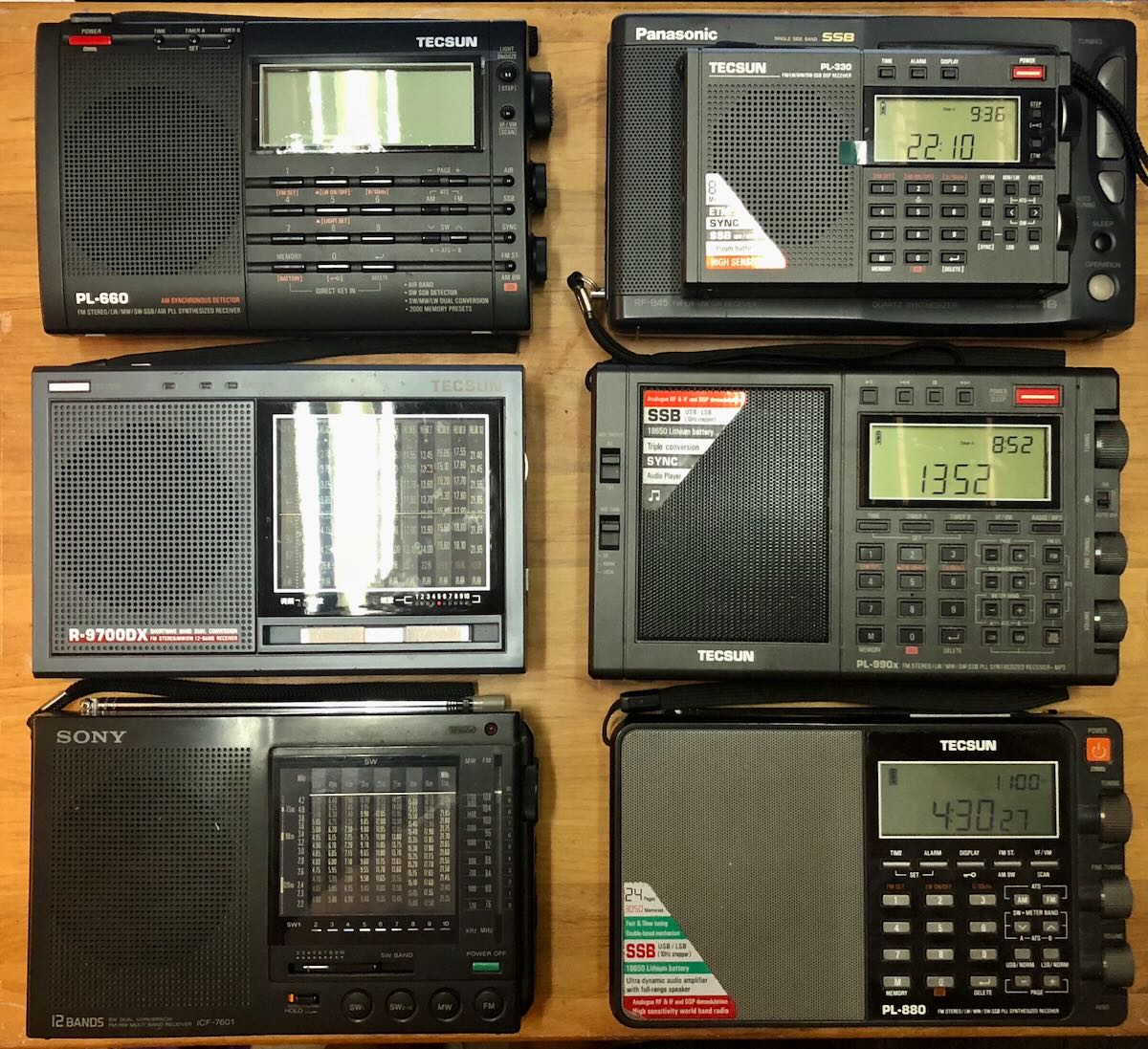
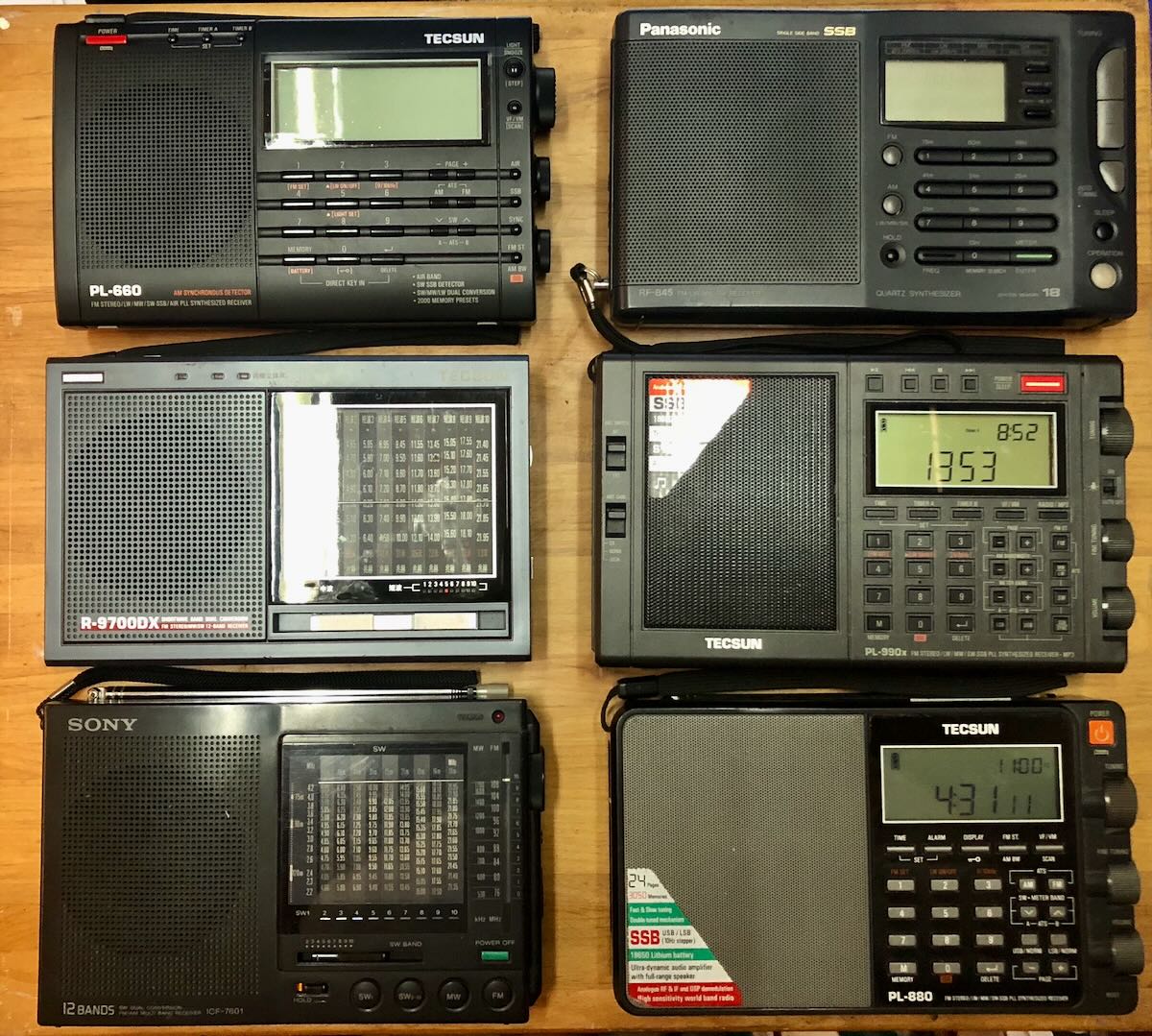
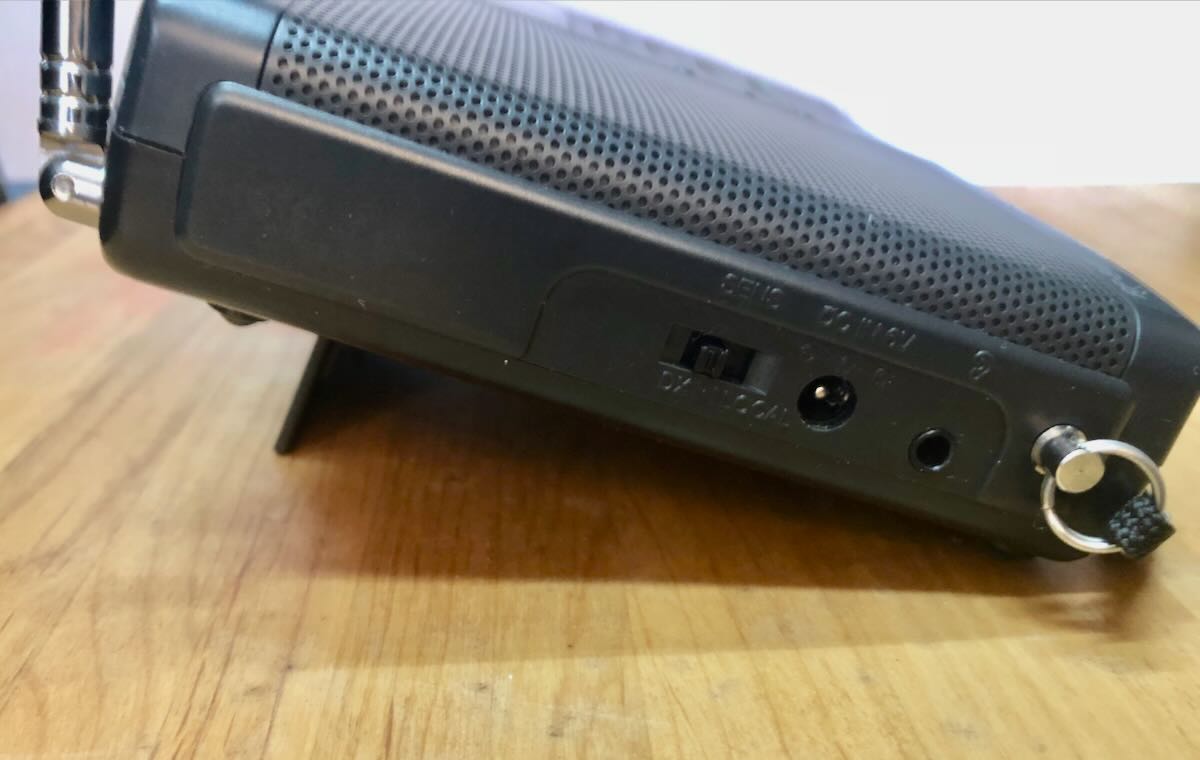
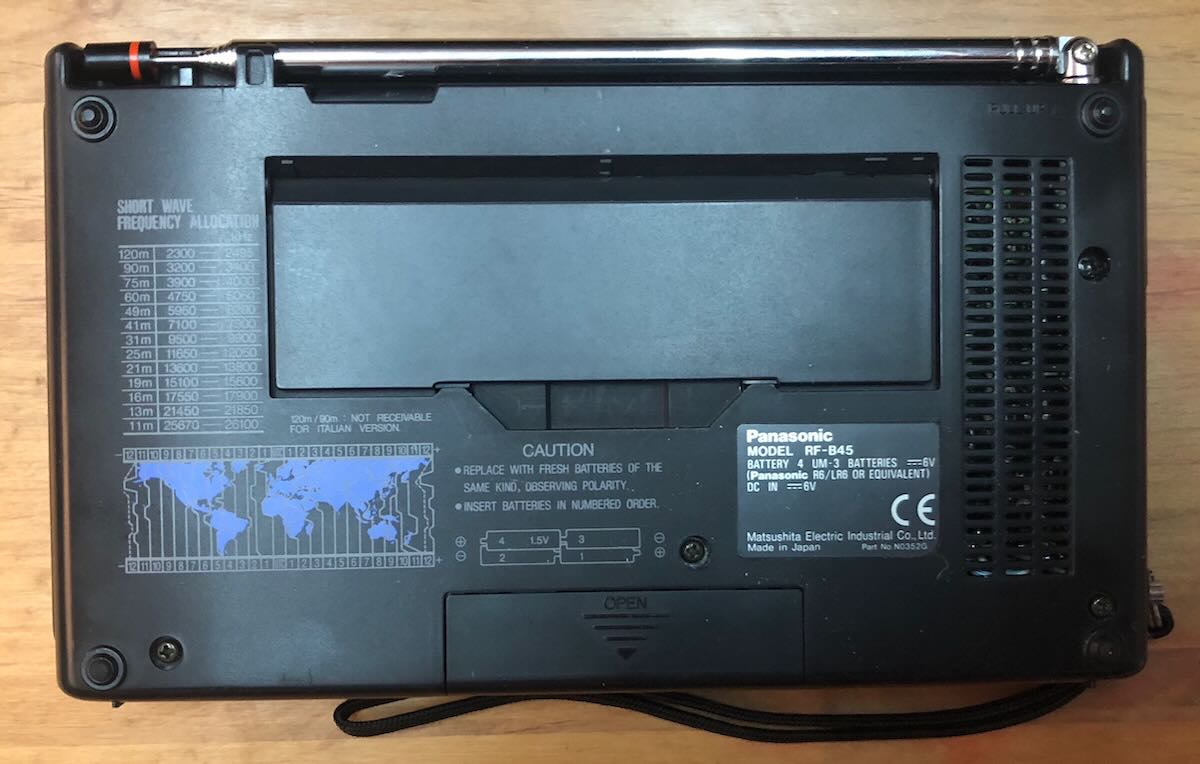

Hi,
I have 1 of these things and have tried different NEW AA batteries but if I press ‘operation’ the ‘E’ starts flickering on the screen. So new AA batteries can’t get this thing running? Tried different types, but so far only the screenclock works. Horrible! Sorry for the frustrated tone, I just don’t get it.
Any help WELCOME!!!!
Mr tech-retard.
Hi rogier,
You may want to check that the battery contacts are clean. No corrosion or oxide. That may drop the battery voltage getting to the radio below the minimum, triggering the error.
Best regards
Yurii,
I have the similar problem in AM, but have the silence instead of white noise. The FM band is fine. I’ve got RF-B45 several decades ago also in Germany. I’ll try to fix it myself.
Friends
Thank you for your replies to my 1st SWLing article.
Thank you for the FET suggestion – a risk I’m aware of, had a protection circuit fitted to one of them – for my 2010s / 2001Ds, sadly its capacitoritis…
In my experience of Hong Kong and China SW radios remain widely available online and in electrical, hardware, general stores and street markets… many of them are cheap and cheerful and I have no idea of their quality… a couple of years ago I picked up a new Degen DE321 from a street stall for HK$98 = aprox US$12.56, I bought it because it intrigued me that something that looks like dolls house furniture might actually be a working SW radio… considering how tiny it is and thus how crammed its bandspread is, it’s actually quite a good performer and for its tiny size it has good audio…
My view that AM radio (including longwave, medium wave and short wave) is an important and valued medium of communication is my personal view based on travels and residence in both maintream and off-the-beaten track Asia-Pacific and hearsay from friends in Africa and Asia-Pacific… I realise this is a subject of debate in SW / AM circles and that there are other views out there… Thank you Dan for the link on PRC SW broadcasts – I’ll read that with interest…
I echo the point about cel phone coverage and Radio / Ham Radio in emergencies. US friends qualified as Hams a few years ago for that reason and within weeks found themselves deployed as part of an emergency response team during and following a hurricane that knocked out other means of communication.
In natural / man-made disasters, nothing beats AM radio for reliable resilient communications…
Well it’s 06.47am here, need to get on with my day…
73
Julian
Thank you, Julian, for sharing this review, and eveyone else who shared their thoughts.
I think no one replied about the differences between the RF-B65 and the RF-B45. There are many, but for me the most relevant technical differences are that the B65 has no gaps in frequencies between LW and MW and that it can tune in 1KHz steps in all AM bands (LW, MW, SW). I can elaborate more details if you are still interested.
Best regards
My favorite short-wave radio station is WTWW. 5.085 MHz. Their call sing means We Transmit World Wide..
Their format is retro 50’s, 60’s and 70’s pop music. They also are a Christian owned radio station. That broadcast Christian music along with advertising Ham Radio related stores. They promote Ham Radio.
So if you need to find WTWW The frequency is 5.085 MHz. This station also has app that you can find on Play store. It’s good to be able to listen to a decent SW radio station.
73
On your dead Sony ICF 2010 / 2001D radios — check the first input FET in the antenna circuit. They are fried easily by atmospheric static. I had two go that way and they were easily repaired with a generic FET.
The high frequency band broadcasting is not all black.
Both Brazil and New Zealand are currently building new high frequency, high powered (100 kW AM/50 kW DRM) transmitters.
The Brazilian transmitter is aimed at the Amazon, but from the much lower powered test transmissions was heard in lots of continental North America. They are going to use Digital Radio Mondiale, to give excellent quality sound, images and indexed text. None of the radios you have tested are capable of receiving DRM.
Radio New Zealand Pacific is aimed at the South Pacific but is often heard in North America. They have been transmitting AM and DRM since 2005.
I should add, that the high operational cost of HF broadcasting is often a reason for closure. DRM broadcasting reduces the electricity consumption by around 60 %.
Remember the AM used in the medium frequency “AM” band and the high frequency SW band. It contains a carrier which is 67 – 100 % of the transmitted power but contains no sound signals. They are in the sidebands. DRM has no carrier!
Good point about the cost, that is certainly an issue.
I wonder If SSB (USB or LSB) would be preferable to DRM?
Many radios available here in the US have SSB, none have drm
DRM is still much better than SSB/DSB even those analogue systems don’t waste energy on carrier like AM.
1. DRM can cope with man-made/natural made noise and interference by good implementing of De-mod algorithm, adjusting bit-rate and other signal parameters.
2.DRM can apply COHERENT receiving technique,ie. you can combine multiple signals from different receivers from different locations to achieve better result. For SSB/DSB analogue system, it could backfire.
3.DRM have better energy effieciency by adding more audio channels in one single 10kHz RF bandwidth.
Everything is good in theory, but in practice some technologies do not work…
Pedro and friends,
Thank you for correction Pedro, it is shortwaveradio.ch
And thank you all friends for your comments. This is my 1st SWLing review.
73
Julian
Great Point !
Thanks to Julian for this nice article about the B45 and various other radios. It is nice to see that there is a good level of enthusiasm out there for shortwave, especially among hobbyists, of which I am one.
Julian makes some good points about BBC cutbacks, which include Persian radio reduction. But as I wrote earlier this year when there was a considerable amount of hopeful discussion about what some suggested could be some new revival of shortwave use due to the Ukraine war, such predictions have not turned into reality.
The assertion that “today and for the foreseeable future the way to reach perhaps half or more of the world’s population is radio, especially Short Wave radio broadcasts”, well that’s just highly unlikely. That CRI and DPRK remain on shortwave is not because there is some huge repository of listeners on the other end tuning SW receivers.
Articles that Keith Perron and I wrote or Radio World earlier in 2022 contains a lot of detail explaining why China continues to broadcast on shortwave (see: https://www.radioworld.com/columns-and-views/guest-commentaries/why-reviving-shortwave-is-a-non-starter and https://www.radioworld.com/columns-and-views/shortwave-revival-a-non-starter-the-authors-respond) contain some explanations, though our position annoyed many in the hobby.
The statement that SW listening is “big in China” seems to me to be a big generalization. That Tecsun, for example, continues to produce receivers does not necessarily constitute proof that there is some huge listenership in China, or elsewhere. Even in areas of Africa that have remained targets for BBC and USAGM/VOA, mobile phone delivery of programming has skyrocketed.
There’s not going to be some massive return to shortwave use there. Even in Myanmar, under renewed tough military control, there’s not going to be some huge revival in use of shortwave receivers. On the question of DRM, which we also covered in our articles — ongoing “tests” of DRM by a number of broadcasters does not mean that 100s of thousands of millions of quality DRM handheld sets, separate from automobile receivers, are going to be on the market any time soon.
You did a good job and the conclusions are correct. But they are correct only for the normal state of affairs. People have too much faith in the sustainability of technology and the internet. But as soon as the electricity is turned off, the Internet is turned off after it. And few devices can work more than a day without charging. I’m sure China has a plan how to destroy satellites and the Internet so that in the dark all over the world people can hear only Chinese stations. In Ukraine, after the blackout on October 10, many people are trying to buy generators and receivers…
Although I am sure that if necessary the US will be able to very quickly build SW transmitters in addition to the already existing network of AM stations.
As sad as it is to admit, your analysis is probably right. I would love to hear that there is a resurgence in Shortwave, but sadly, I don’t see it, either.
The problem, of course, is the public’s total disinterest in Shortwave, in fact, of Radio in general.
The only radios my kids have are the ones in their cars.
This is a shame, as Shortwave (and Radio in general) will work when the Internet doesn’t.
I read somewhere that during a large outbreak of fires in California, some ignorant politician was blaming the Cell phone company for lack of signal, as the residents were using their smartphones to keep informed about the direction of the fires. Funny enough, the cell phone company responded that many of their cell sites were consumed by those same fires.
I shook my head at this – did that politician ever hear of AM Radio?
During Hurricane Sandy, many people commented about my ability to get information and communicate via my Ham club’s 2-meter repeaters. That interest, sadly, completely disappeared a few weeks after the Hurricane.
There is always the chance – probably a very small chance – that Radio and Shortwave could become popular again, like vinyl records.
One could only hope.
I would like to know how well the RF-B45 performs on SSB.
Dave,
IMO the RFB-45 performs quite well on sideband and cw.
Unlike the RFB-65,the bfo in the ’45 was part of the original
design and not added on.
It does not have upper or lower sideband but performs
quite well,similar to the old model Kaito-Tecsun 1103.
The only negative mark I gave it was that longwave only
covered 150 to 279 khz for longwave broadcast only.
Thanks for the interesting review. I have never seen this model, and even B65 is rare. But I completely disagree with your assessment of the reception quality compared to the Chinese. From my experience, even if we are not talking about bad capacitors, every old radio needs to be aligned. For example, after aligning Sony7600 https://antiqueradios.com/forums/viewtopic.php?f=4&t=415560 , according to the owner, it began to receive better than all his other newer receivers. I recommend that you do the restoration and alignment of the receiver and compare it with the Chinese again.
Great Point !
Lovely PLL radio. I can’t praise enough these radios.
One comment on the whole cut back thing: sadly it’s not just SW that’s threatened. LW and MW are getting more and more gutted. Governments and authorities don’t seem to get the importance of strong LW/MW particularly in case of natural disaster, armed conflicts, etc.
On the Panasonic: one thing i don’t like the radio, which I’ve accustomed to is the tuning knob. I love those. Other than that, i can only dream of the smoothness of tuning this device may have and the sound it produces.
Just a correction: i can’t seem to find the website “shortwave.ch”, I think the correct one is “shortwaveradio.ch”
Amazing article, by the way.
I’ll admit I never knew about the RF-B45 , only of the RF-B65
I’ve got RF-B45 recently.
Something wrong to AM range.
There is no useful signal at any frequency in the AM band, only white noise. The signal quality indicator at almost any frequency shows a good signal. A similar story with the FM band, but picks up stations. Because of this, auto-tuning does not work, it stops immediately after launch, mistakenly focusing on supposedly confident reception of white noise. There is a three-way switch, ssb/fix, changing mode gives no effect. My grandfather had the same one, and he worked well. This unit recently sent from Germany. Any suggestions, does this fixable?